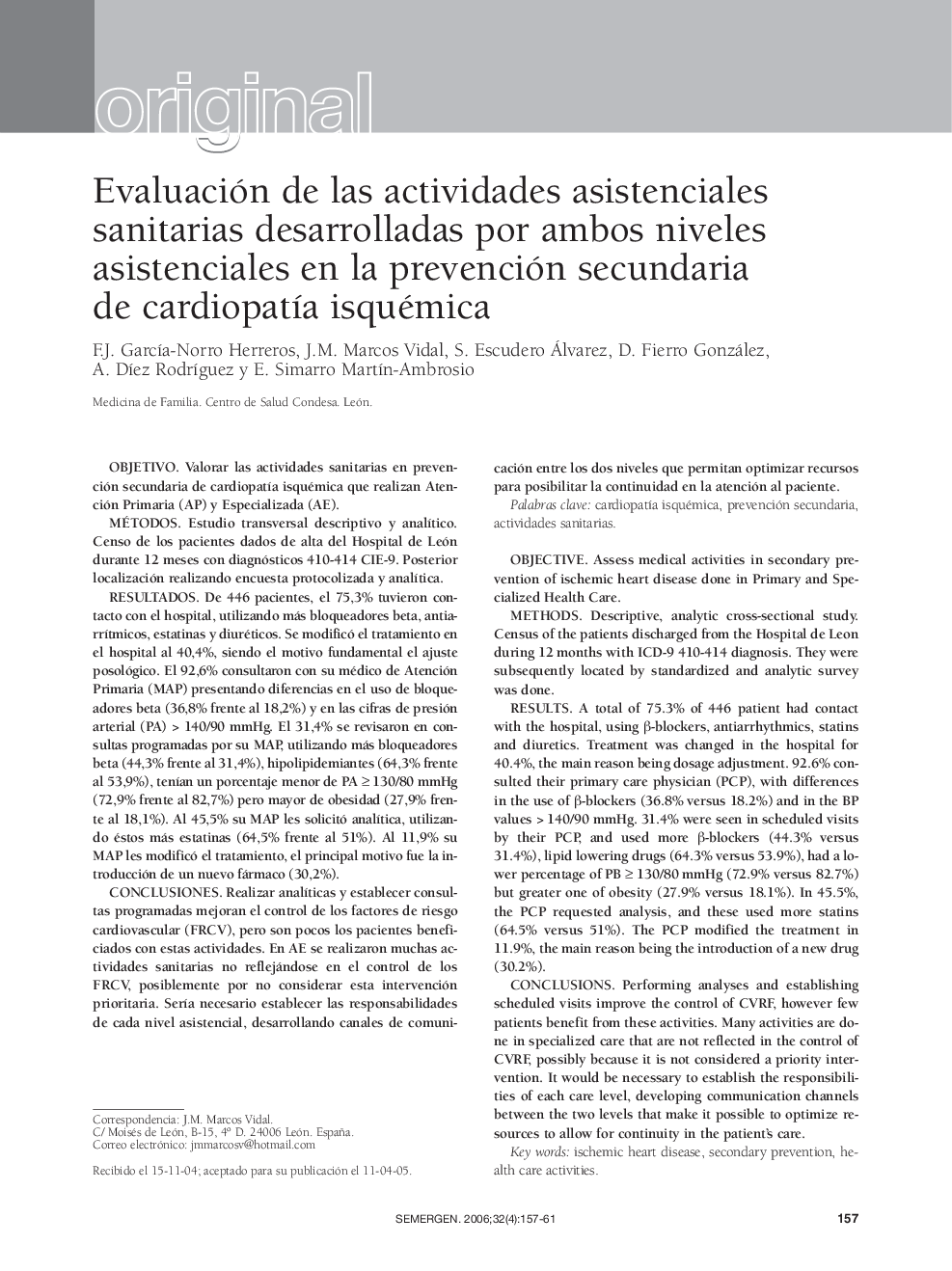| Article ID | Journal | Published Year | Pages | File Type |
|---|---|---|---|---|
| 3835864 | SEMERGEN - Medicina de Familia | 2006 | 5 Pages |
ObjetivoValorar las actividades sanitarias en prevención secundaria de cardiopatÃa isquémica que realizan Atención Primaria (AP) y Especializada (AE).MétodosEstudio transversal descriptivo y analÃtico. Censo de los pacientes dados de alta del Hospital de León durante 12 meses con diagnósticos 410-414 CIE-9. Posterior localización realizando encuesta protocolizada y analÃtica.ResultadosDe 446 pacientes, el 75,3% tuvieron contacto con el hospital, utilizando más bloqueadores beta, antiarrÃtmicos, estatinas y diuréticos. Se modificó el tratamiento en el hospital al 40,4%, siendo el motivo fundamental el ajuste posológico. El 92,6% consultaron con su médico de Atención Primaria (MAP) presentando diferencias en el uso de bloqueadores beta (36,8% frente al 18,2%) y en las cifras de presión arterial (PA) > 140/90 mmHg. El 31,4% se revisaron en consultas programadas por su MAP, utilizando más bloqueadores beta (44,3% frente al 31,4%), hipolipidemiantes (64,3% frente al 53,9%), tenÃan un porcentaje menor de PA â¥Â 130/80 mmHg (72,9% frente al 82,7%) pero mayor de obesidad (27,9% frente al 18,1%). Al 45,5% su MAP les solicitó analÃtica, tilizando éstos más estatinas (64,5% frente al 51%). Al 11,9% suMAP les modificó el tratamiento, el principal motivo fue la introducción de un nuevo fármaco (30,2%).ConclusionesRealizar analÃticas y establecer consultas programadas mejoran el control de los factores de riesgo cardiovascular (FRCV), pero son pocos los pacientes beneficiados con estas actividades. En AE se realizaron muchas actividades sanitarias no reflejándose en el control e los FRCV, posiblemente por no considerar esta intervención prioritaria. SerÃa necesario establecer las responsabilidades de cada nivel asistencial, desarrollando canales de omunicación entre los dos niveles que permitan optimizar recursos para posibilitar la continuidad en la atención al paciente.
ObjectiveAssess medical activities in secondary prevention of ischemic heart disease done in Primary and Specialized Health Care.MethodsDescriptive, analytic cross-sectional study. Census of the patients discharged from the Hospital de Leon during 12 months with ICD-9 410-414 diagnosis. They were subsequently located by standardized and analytic survey was done.ResultsA total of 75.3% of 446 patient had contactwith the hospital, using β-blockers, antiarrhythmics, statins and diuretics. Treatment was changed in the hospital for 40.4%, the main reason being dosage adjustment. 92.6% consulted their primary care physician (PCP), with differences in the use of β-blockers (36.8% versus 18.2%) and in the BP values > 140/90 mmHg. 31.4% were seen in scheduled visits by their PCP, and used more β-blockers (44.3% versus 31.4%), lipid lowering drugs (64.3% versus 53.9%), had a lower percentage of PB ⥠130/80 mmHg (72.9% versus 82.7%) but greater one of obesity (27.9% versus 18.1%). In 45.5%, the PCP requested analysis, and these used more statins (64.5% versus 51%). The PCP modified the treatment in 11.9%, the main reason being the introduction of a new drug (30.2%).ConclusionsPerforming analyses and establishing scheduled visits improve the control of CVRF, however few patients benefit from these activities. Many activities are done in specialized care that are not reflected in the ontrol of CVRF, possibly because it is not considered a priority intervention. It would be necessary to establish the responsibilities of each care level, developing communication channels between the two levels that make it possible to optimize resources to allow for continuity in the patient's care.
